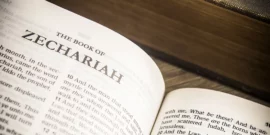Hints of the Trinity in the Old Testament (Part 1): Daniel 7

The Trinity—God existing as three distinct persons in one divine essence—is often viewed as a New Testament concept. Yet, this profound truth is actually woven throughout all of Scripture, including the Old Testament. In this series, we will explore how this is the case by examining five key passages that foreshadow the Trinity.
We begin with four Messianic passages that clearly hint at the plurality within the Godhead, primarily focusing on the relationship between the Father and the Son. These passages provide a strong foundation for understanding how the Old Testament anticipates the later, fuller revelation of God’s triune nature.
To provide a more comprehensive view of trinitarian foreshadowing, we then turn our attention to a passage about the Holy Spirit. This addition allows us to explore how the Old Testament not only points to the divinity and distinctness of the Messiah, but also presents the Spirit as a divine person within the Godhead.
For each passage, we will consider:
- How the Messiah or the Spirit is described as sharing in God’s essence
- How they are simultaneously portrayed as distinct persons
- How the passage finds its ultimate fulfillment or further elaboration in the New Testament
By studying these prophecies, we’ll uncover the remarkable foreshadowing of Trinitarian theology in the Old Testament, demonstrating the unity and coherence of God’s revelation throughout Scripture. We’ll see how these once enigmatic passages suddenly become clear when viewed through the lens of the New Testament, offering a richer understanding of God’s triune nature.
This approach allows us to trace the development of trinitarian concepts throughout Scripture, showcasing how God progressively revealed His complex nature to His people, culminating in the full revelation brought by Christ and the outpouring of the Spirit.
Daniel 7:13-14
Let’s examine our first Old Testament passage that hints at the Trinity: Daniel 7:13-14. This prophetic vision provides a remarkable foreshadowing of Trinitarian concepts, particularly in its portrayal of the Messiah sharing in God’s essence while remaining a distinct person within the Godhead.
The passage reads:
“In my vision at night I looked, and there before me was one like a son of man, coming with the clouds of heaven. He approached the Ancient of Days and was led into his presence. He was given authority, glory and sovereign power; all nations and peoples of every language worshiped him. His dominion is an everlasting dominion that will not pass away, and his kingdom is one that will never be destroyed” (Daniel 7:13-14).[1]
Let’s explore how this passage indicates the Messiah’s divine essence and His distinct personhood:
The passage presents a figure described as “one like a son of man” who exhibits several divine attributes.
- Divine Arrival: He comes “with the clouds of heaven” (7:13) — imagery consistently associated with divine appearances in the Old Testament (e.g., Exodus 34:5, Psalm 104:3).
- Divine Authority: “He was given authority, glory and sovereign power” (7:14) — authority attributed exclusively to God.
- Divine Worship: “all nations and peoples of every language worshiped him” (7:14) — an honor Israelites strictly reserved for God alone.
- Divine Reign: “His dominion is an everlasting dominion that will not pass away, and his kingdom is one that will never be destroyed” (7:14) — The eternal and indestructible nature of His reign transcends earthly kingship and echoes descriptions of God’s own eternal reign.
This series of divine descriptions makes it clear that this “one like a son of man” will be none other than God Himself.
Distinct in Person
Intriguingly, the passage also hints at a distinction of persons within the Godhead.
- Distinct Approach: “He [the one like a son of man] approached the Ancient of Days [a title for God] and was led into his presence” (7:13) — This approach implies a distinction between the “Son of Man” and the “Ancient of Days.”
- Distinct Bestowal of Authority: “He was given authority, glory and sovereign power” (7:14) — This interaction, where the Ancient of Days gives authority to the Son of Man, suggests a relationship between distinct divine persons.
Overall, Daniel’s vision presents us with a fascinating theological paradox: a figure both unmistakably divine and yet distinct from God. This “one like a son of man” bears the hallmarks of deity—receiving worship, wielding supreme authority, and reigning eternally. Yet, He approaches and interacts with the Ancient of Days, suggesting a separate personhood. At first glance, such a portrayal challenges the very foundations of Israel’s monotheism, encapsulated in the Shema: “Hear, O Israel: The LORD our God, the LORD is one” (Deuteronomy 6:4). This apparent tension between God’s oneness and the duality presented in Daniel’s vision sets the stage for a profound mystery—one that finds its ultimate resolution in the doctrine of the Trinity.
Fulfilled in Christ
Throughout His earthly ministry, Jesus revealed how the theological tension presented in Daniel’s vision finds its fulfillment in Him. By adopting “the Son of Man” as His favorite self-designation—using it over 80 times—Jesus deliberately aligned Himself with Daniel’s prophetic figure. Through His words and actions, Jesus vividly brought this enigmatic vision into sharp focus, demonstrating how He embodied the dual nature of the “one like a son of man”—at once fully divine and yet distinct from the Father. Let’s examine how a few of Jesus’ teachings and claims illuminate this profound Old Testament foreshadowing of the Trinity.
Divine Essence:
- As the Son of Man, Jesus claimed authority to forgive sins on earth: “But that you may know that the Son of Man has authority on earth to forgive sins…” (Mark 2:10).
- He asserted lordship over the Sabbath: “So the Son of Man is Lord even of the Sabbath” (Mark 2:28).
- He declared He would come on the clouds of heaven: “And you will see the Son of Man sitting at the right hand of the Mighty One and coming on the clouds of heaven” (Mark 14:62).
- He stated that He would sit at the right hand of Power (Same verse as above, Mark 14:62). In response to Jesus’ declaration, the high priest tore his robes and cried out, “Blasphemy!” This visceral reaction demonstrates that Jesus’ self-identification with Daniel’s Son of Man was immediately recognized as an unmistakable claim to deity.
- He claimed authority to execute judgment: “And he has given him authority to judge because he is the Son of Man” (John 5:27).
Distinct Personhood:
- Jesus spoke of the Father authenticating Him as the Son of Man: “Do not work for food that spoils, but for food that endures to eternal life, which the Son of Man will give you. For on him God the Father has placed his seal of approval” (John 6:27).
- He affirmed the Father’s delegation of divine prerogatives to the Son of Man: “For as the Father has life in himself, so he has granted the Son also to have life in himself. And he has given him authority to execute judgment, because he is the Son of Man” (John 5:26-27).
- He referred to the Father glorifying the Son of Man: “Now the Son of Man is glorified and God is glorified in him” (John 13:31).
Conclusion
Daniel 7:13-14 provides a clear example of how the Old Testament, even centuries before Christ, contained glimpses of God’s Triune nature that would be fully revealed in the New Testament. This passage, with its portrayal of a divine yet distinct Messianic figure, foreshadows the complex unity of the Trinity, demonstrating the consistency of God’s self-revelation throughout Scripture.
- All passages of Scripture are quoted from the NIV. ↑








